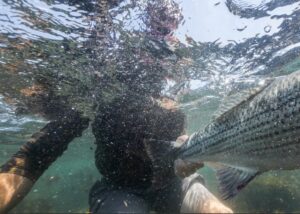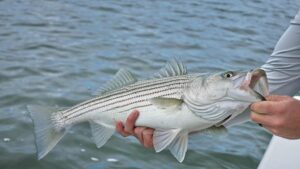
No, Striped Bass Are Not “Back” in North Carolina
This week, an Axios Raleigh article made the rounds claiming there may have been a strong wild spawn of striped bass in North Carolina’s Roanoke
Striped bass are the lynchpin species along the East Coast, providing millions of recreational fishing trips and supporting countless coastal communities. Striped bass are managed by the Atlantic States Marine Fisheries Commission, an interstate compact of states along the Atlantic coast. Since our inception, ASGA has engaged in every striped bass management issue in a meaningful and productive manner. We have worked tirelessly to ensure striped bass anglers are informed about this beloved fishery and that they understand the impact their voices can have on its management. We believe that the striped bass fishery is at an inflection point: if action is not taken to correct our course, the stock will not rebuild by the required timeline.


In addition to empowering our community of striper advocates, ASGA is working with the GotOne app to assist Massachusetts Division of Marine Fisheries’ catch-and-release mortality research. Striped Bass scientists and management use a 9% C&R mortality rate, which comes from the Diodati study (that explicitly cautioned against using this conclusion for management). ASGA is hoping that this research and citizen science collaboration will shed light on a more accurate C&R mortality rate with substantial implications for management. While ASGA is not inherently opposed to harvesting striped bass, the simple fact is that recreational anglers kill far too many bass and a lot of fish die after release. While the health of the striped bass resource is paramount, ASGA stands firmly opposed to most no-targeting closures within this fishery. It is punitive, unenforceable, and unquantifiable at this time.
While it is clear that some areas experienced excellent striped bass fishing in the last two seasons, it is important to remember the dynamics of a balanced population and a coastwide fishery. The good fishing was a result of one of the most prolific year classes on record reaching maturity. ASGA had deep concerns that the slot limit would fully exploit the robust 2015-year class when it was proposed. These concerns have now become a reality. The early outlook for the sixth (6!) consecutive year of spawning records does not provide any more hope. This leaves the stock and those that depend on a healthy striped bass population in a very dangerous place.
Amendment 7, which was approved and implemented in May 2022, clearly states that the stock must be rebuilt within 10 years by 2029. This current rebuilding plan faces immense uncertainty, meaning it may very well fail. After the high volume of recreational harvest in 2022 (largely driven by the prolific 2015-year class) the probability of rebuilding nose-dived to around 15%. The Board did react with the Emergency Action and Addendum II, and initiating those course corrections then were far better than imposing draconian measures in a few years – a concept supported by the angling community at large. However, all eyes now are on the 2024 stock assessment scheduled for later this fall, which will tell us what other actions may be needed—we are anxiously waiting to learn more and will be ready to encourage the Striped Bass Board to do what is necessary to rebuild this stock and ensure its long-term abundance.
In recent years, the ASMFC Striped Bass Board has taken important steps to ensure striped bass rebuild by 2029, but due to five consecutive years of terrible recruitment in the Chesapeake Bay, ASGA remains deeply concerned. All eyes are now on the 2024 Stock Assessment, scheduled for release later this Fall.
Five consecutive years of abysmal recruitment in the Chesapeake Bay, which produces 70-90% of the coastwide stock, spells a looming disaster for this fishery, and managers’ ability to control fishing mortality is an annual struggle. We have reason to believe 2024 spawns provide little relief (average at best). A new stock assessment will be released this fall 2024, providing Striped Bass Board Members a roadmap for successfully rebuilding this stock by 2029. Despite the positive management actions the past couple of years, more actions may be needed considering how abysmal recruitment has been and the degree to which we’ve removed the 2015-year class. Come 2027-2030, anglers will begin to feel the effects of this terrible trend of recruitment. The holes in the age population will be a real problem when the current prolific classes become less available. We believe that the striper fishery continues to find itself at inflection points: if management does not prioritize precautionary management, the stock will not rebuild by the required timeline and the many striped bass communities will suffer.
The 2015-year class is the last robust recruitment year. While the 2017 and 2018 year classes are average, there are five consecutive years of the lowest recruitment in recent history following. This leaves the stock and those that depend on a healthy striped bass population in a very dangerous place. We don’t really have any new fish entering the system. Therefore, ASGA firmly believes that we must keep as many fish in the system as possible to both contribute to spawning biomass and to take advantage of favorable spawning conditions when they occur.

This week, an Axios Raleigh article made the rounds claiming there may have been a strong wild spawn of striped bass in North Carolina’s Roanoke

Feature Photo Credit: Robbie Tartaglia What’s going on? For decades, striped bass management relied on a 9% release-mortality estimate from a 1990s study that even its

What’s going on? The “most important fish in the sea” just exposed one of the biggest management failures in decades. A new assessment shows Atlantic

Imagery Courtesy of Sean Cobelli Media We encourage anglers, guides and conservationists to use this public comment as a resource when participating in the upcoming

Fisheries management along the Atlantic coast is a mess, and the Atlantic States Marine Fisheries Commission (ASMFC) continues to prove why with its latest moves

Striped bass anglers from Maine to Virginia have spent years navigating shifting regulations meant to protect the fish we love. However, among the most confusing
GIVE THE GIFT OF FISHERIES CONSERVATION THIS HOLIDAY SEASON. SHOP ASGA GOODS THAT FUND FISHERIES RESEARCH & ADVOCACY CAMPAIGNS
JOIN ASGA IN CALLING FOR CRITICAL MANAGEMENT ACTION AFTER YEARS OF SPAWN FAILURES & POOR MANAGEMENT.
By using this website, you agree to our use of cookies. We use cookies to provide you with a great experience and to help our website run effectively. To learn more, please review our privacy policy.